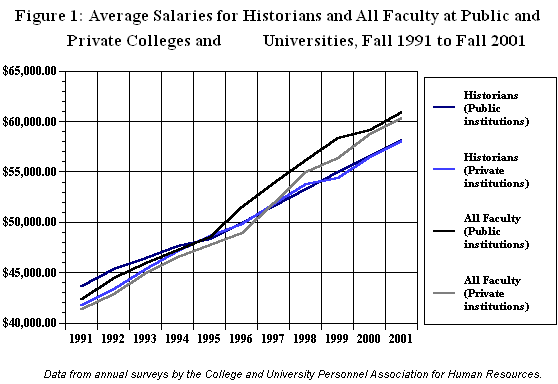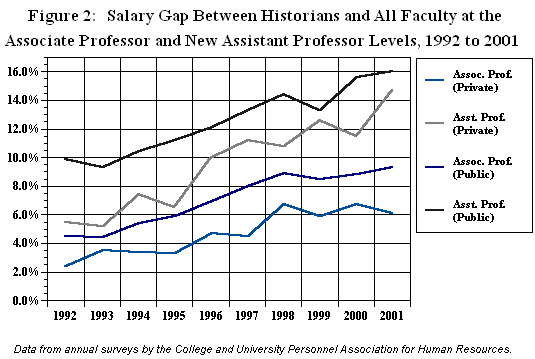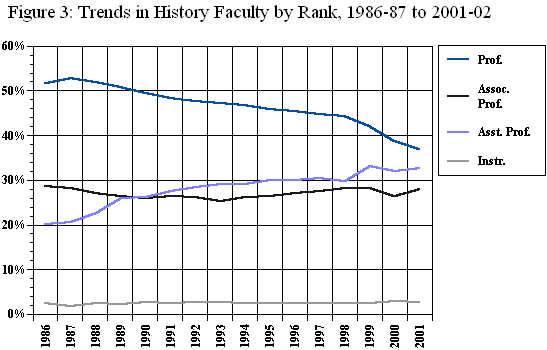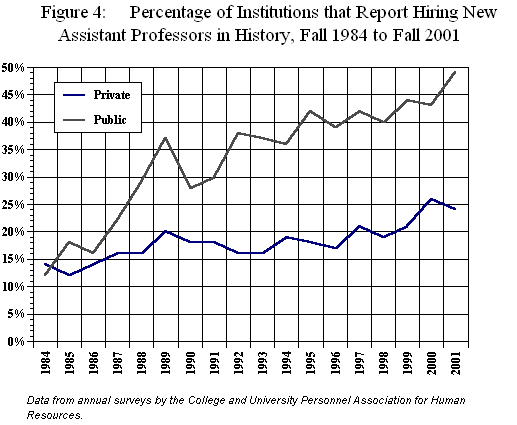News
The 2001–02 Salary Report: History Gains Some Ground, but Job Market Is Taking a Toll
Salaries for historians at American colleges and universities grew faster than the rate of inflation last year, and even gained a bit of ground relative to the rest of the academy. However, a closer examination of the salaries, particularly of new junior faculty, indicates that the poor history job market has begun to erode history instructors' salaries for the long term.
According to the annual salary survey conducted by the College and University Personnel Association—Human Resources (CUPA-HR), average salaries for historians at private colleges and universities rose 2.8 percent, to $58,050, while average pay at public institutions rose 3.0 percent, to $58,106. 1
The CUPA-HR data provides some further good news, however modest. At private colleges and universities, historians managed to gain some ground compared to other fields, after lagging significantly behind for a number of years. Salaries for faculty members in all fields at private institutions rose by 2.7 percent, to $60,289. Even though the difference was quite small—a scant 0.1 percent—it marked a reversal from the previous five years, when raises for history faculty lagged as much as 2.1 percent behind all other fields
The situation was quite similar for faculty in public colleges and universities, where salaries for both historians and for all the fields rose 3 percent. The average salary for faculty in all fields was $60,893.
There were some notable differences between the ranks, however, most notably for new assistant professors in history, whose salaries in private institutions rose only 1.8 percent last year. 2 This stands out when compared to more generous increases of around 3.5 percent for continuing faculty in all ranks. In comparison, salaries for new assistant professors of history at public colleges rose 5.9 percent, almost twice the average for the discipline. Viewed over the long term, slightly better annual gains at public institutions over the past five years have expanded a gap in salaries for new assistant professors, such that average salaries at this rank were 4.5 percent higher than in private colleges and universities last year.
Unfortunately, the CUPA-HR survey lacks key information on benefits—an essential part of any payment package these days—and breaks up the data by institutional control, making it impossible to analyze salaries for the field as a whole. The survey does provide the only annual data on academic salaries by discipline, however, so we rely on it for detailed information on history faculty salaries at particular ranks and comparative data for other fields.
The CUPA-HR data does not provide discipline-level information on the salaries for part-time faculty. However, according to the most recent data collected by the AHA, average salaries for faculty paid by the course stood at $3,109 per course in 2000–01. 3
Is the Job Market Depressing History Faculty Salaries?
The most troubling data in the CUPA-HR survey shows the relative erosion of salaries for history faculty, particularly at the junior level. Given the recent fluctuations in the history job market, this is hardly surprising, since a high level of competition for jobs undercuts demands for a better starting salary. As a result, the discipline is now running well below the average for all fields, and even lagging behind other fields in the humanities and social sciences, after enjoying above-average earnings until the mid-1990s (Figure 1).

The substantial effects of the poor job market become evident when the salaries for historians at the new assistant professor level are compared to their counterparts in the rest of the academy (Figure 2). In 1992–93 the difference between average salaries for new assistant professors in history and the rest of the academy was about 10 percent in public institutions—new assistant professors in history earned an average of $31,515 as compared to $34,639 in all fields. At private colleges and universities the difference was narrower (only 6 percent), as new historians earned an average of $31,111 as compared to $32,820 for their counterparts in all fields.

As the history job market soured in the 1990s, that gap grew sharply. At private institutions, the difference more than doubled to 14.6 percent, with new hires in history taking home an average of $41,731 as compared to $48,401 in all fields. At public colleges and universities the gap didn't grow as dramatically, but it was already quite wide. Last year, new assistant professors of history in state-controlled programs earned an average of $39,940, almost 16 percent below the $45,806 average for all fields.
Salaries for junior historians have thus fallen to the level of salaries in other fields that have also been similarly affected by the adverse job market—salaries for new assistant professors in history are now almost indistinguishable from salaries of new hires in the field of English, philosophy, and fine arts. Disturbingly, history now lags more than 3 percent behind foreign languages and all the other disciplines CUPA-HR surveyed in the social sciences (anthropology, economics, geography, political science, and sociology).
The long-range effects of the relative decline in the fortunes of junior faculty is now showing up at the associate professor level—as the new assistant professors of 10 years ago have begun to move into the ranks of tenured faculty. The salary gap for associate professors in private institutions grew from 2.4 to 6.1 percent, while the gap at public colleges and universities expanded from 4.5 to 9.3 percent. The difference in real dollars at the associate professor level is now $5,036 at public institutions and $3,318 at privates.
It is only at the full professor level that the field still retains a slight salary advantage over some of the other social science fields like anthropology, geography, and sociology.
Popping the Demographic Bubble
The CUPA-HR surveys do offer some hopeful news on the job market, however, as they provide additional demographic data about the numbers of full-time faculty at each rank, highlighting the significant generational shift now taking place in history departments. As Figure 3 demonstrates, the ranks of full professors in history departments have fallen sharply over the past decade, as the long predicted wave of senior faculty retirements began to rise. 4

This increase in retirements has opened the way for junior historians seeking full-time jobs in the field, and the average number of new faculty hired by each department rose for the third year in a row (though more modestly than in past years).

More than a third of all history departments in the survey reported hiring new assistant professors in the fall of 2001, for a total of 362 new junior faculty at the reporting institutions.
This reinforces the conclusions reported in our surveys of the job market over the past few years, which have shown a marked increase both in the number of retirements from the senior levels and the number of new assistant professors hired. The data in the CUPA-HR surveys supports our findings that these openings are being produced by a growing number of retirements from the top ranks.
This shift is particularly notable at public colleges and universities. Less than 10 years ago, the prevalence of historians at the full professor level (almost 54 percent of department faculty) drew comment from the authors of the survey, who marked the field as one of the most "top heavy" in the academy. Since that time, the proportion in the top rank has fallen by almost a third, to just 36.4 percent of department faculty. Nevertheless, history remains "top heavy" relative to other disciplines. While 37 percent of the full-time history faculty (at public and private institutions) are full professors, only 32 percent of the faculty in all fields are in the top rank. This offers continued reason for thinking the wave of retirements will continue for at least a few more years.
Unfortunately, as we noted in the earlier report, however dramatic the increase in hiring might be, the number of available jobs still lags well behind the number of new PhDs being produced, which reached 1,066 in 2000.
—Robert Townsend is assistant director for research and publications at the AHA.
Notes
1. CUPA-HR, National Faculty Salary Survey by Discipline and Rank in Private Colleges and Universities (published annually for the academic years 1986—87 through 2001—02), and CUPA-HR, National Faculty Salary Survey by Discipline and Rank in Public Colleges and Universities (published annually for the academic years 1986—87 through 2001—02). Salary figures are based on a nine- or ten-month academic year, full-time faculty only. Fringe benefits and summer earnings are excluded. Copies can be obtained from CUPA-HR at 1233 20th St. NW, Ste. 301, Washington, DC 20036-1250. (202) 429-0311.
2. The "new assistant professor" category in the CUPA-HR taxonomy includes all those hired at, or promoted to, the assistant professor rank in the fall of 2001.
3. Data collected in the Annual Survey of History Departments 2000—01 in the spring of 2002. The survey was sent to 683 programs listed in the over the past two years, and received responses from 388 (56 percent). 287 programs reported employing part-time faculty, and 280 provided valid data on their salaries. It should be noted, however, that given the nature of the surveyed population (with a large number of better endowed PhD-granting programs and 4-year institutions), this estimate is higher than it would be if all institutions where history is taught could be surveyed.
4. Robert B. Townsend, "Job Market Report 2001: Openings Booming . . .but for How Long?" Perspectives(December 2001), p. 5.
Tags: Profession
Comment
Please read our commenting and letters policy before submitting.






